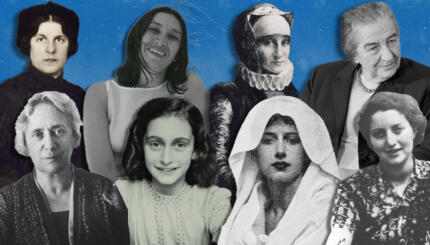The remarkable Henrietta Szold was born in 1860 in Baltimore, Maryland, the child of Rabbi Benjamin Szold and his wife Sophie. A political liberal and a religious traditionalist, Rabbi Szold taught his daughter German, Hebrew, and the Jewish sacred texts to supplement her public school education. In her teens she began to work as a translator and an editor. She later became a teacher and wrote for a number of Jewish journals.
In 1888 she was chosen to be one of the nine members of the publication committee of the Jewish Publication Society (JPS). The only woman on the committee, she collaborated with Cyrus Adler on a contribution to JPS’s first publication, Outlines of Jewish History. She also helped to edit Heinrich Graetz’s classic History of the Jews. In 1893 she became executive secretary of the publications committee and, for over two decades, was instrumental in the editing, translating, and publication of some of the most important works in American Judaism.
Founding the Largest American Zionist Organization
One of the first proponents of Zionism, she gave a speech in 1896 outlining her philosophy—Jews should be allowed to return to their ancient homeland and Jews should work to revive Jewish culture. In 1898 she became a member of the Federation of American Zionists (FAZ) executive committee, the only women in the group.
READ: Jews and Arabs in British Mandate Palestine

Help us keep Jewish knowledge accessible to millions of people around the world.
Your donation to My Jewish Learning fuels endless journeys of Jewish discovery. With your help, My Jewish Learning can continue to provide nonstop opportunities for learning, connection and growth.
In 1909 Szold visited Palestine and became intensely involved in the work to reconstruct the Jewish homeland. At the age of 49 she had discovered her vocation. She devoted the rest of her life to Palestine — the promised land. Back in America she founded Hadassah, the Zionist organization for women. This group was by no means a “ladies auxiliary” to male Zionist organizations. Under Szold’s leadership, in fact, it became larger and more powerful than any other Zionist group in the country. Among its projects was providing medical care and education to the Jewish community in Palestine. During the 1930s, Hadassah expanded its work to include the Youth Aliyah programs for settling and educating young refugees from Nazi Europe.
READ: Pre-State Israel’s Jews Respond to the Holocaust
In 1920 Szold arrived in Palestine to personally take charge of Hadassah’s medical unit. She settled there and devoted the remaining 25 years of her life to humanitarian work with the Jews of her adopted land. Her work, both in providing health care and educational services to the residents of Palestine and in rescuing children from the Holocaust, earned her the title, “mother of the yishuv” (the Jewish community in Palestine). The Youth Aliyah program could not have succeeded to the extent that it did without her mastery of the administrative complications involved in “liberating” children from Europe, transporting them to a new country, and ensuring that their physical and emotional needs were met in this strange, new land.
Although her cultural roots were clearly in the United States (at her last Passover in 1944 she sang African-American spirituals), Szold had clearly become a “resident” of her adopted homeland. She died in 1945, three years before the creation of the State of Israel, which she had done so much to make possible.
Reprinted with permission from the American Jewish Historical Society’s American Jewish Desk Reference: The Ultimate One-Volume Reference to the Jewish Experience in America, published by Random House.


